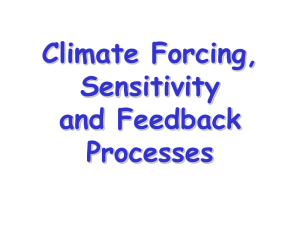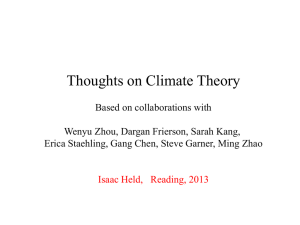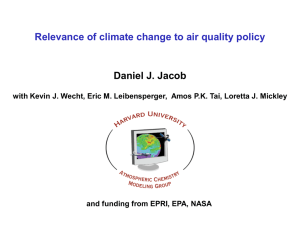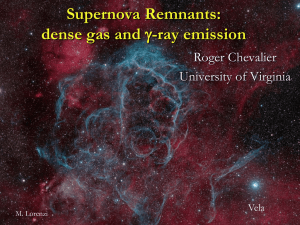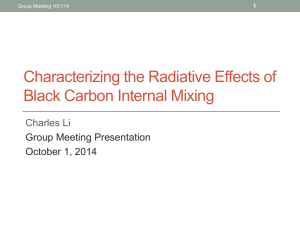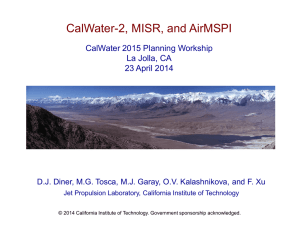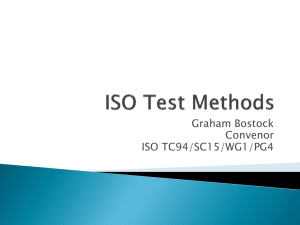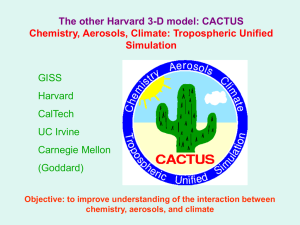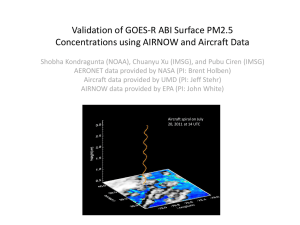Aerosol radiative effects from satellites
advertisement
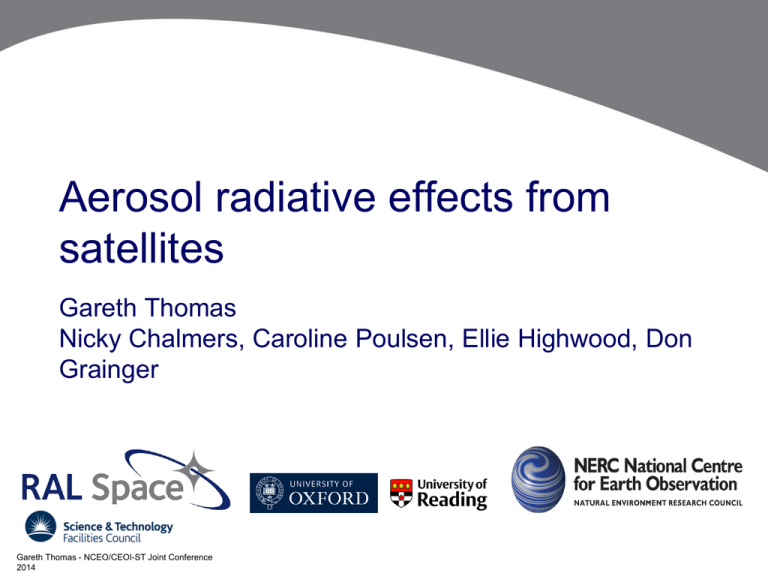
Aerosol radiative effects from satellites Gareth Thomas Nicky Chalmers, Caroline Poulsen, Ellie Highwood, Don Grainger Gareth Thomas - NCEO/CEOI-ST Joint Conference 2014 Overview • • • • Motivation: – why calculate aerosol radiative effect – connection to radiative forcing Methodology: – aggregation of satellite data into regional, monthly estimates – uncertainty and error analysis – radiative calculations Radiative forcing? What next See: G.E. Thomas et al., Atmos. Chem. Phys., 13:393-410, 2013 Gareth Thomas - NCEO/CEOI-ST Joint Conference 2014 Nomenclature Aerosol radiative effect Aerosol radiative forcing Difference between the net downwelling broadband flux with and without aerosol at some atmospheric level: Follow the IPCC definition: change in radiative effect at topof-atmosphere since 1750: ΔR = (F↓ – F↑)aerosol – (F↓ – F↑)”clean” Rf = (F↓ – F↑)present – (F↓ – F↑)1750 Note: aerosol radiative forcing is only takes account of changes in aerosol itself Gareth Thomas - NCEO/CEOI-ST Joint Conference 2014 Why calculate aerosol radiative effect • Climatically speaking aerosol is important for two reasons: 1. 2. • • Scattering and absorption of solar radiation Their influence on cloud properties Aerosol can result in either a significant cooling or warming at the surface Calculating the radiative effect is relatively straight forward (compared to forcing) IPCC AR5: Radiative forcing breakdown Gareth Thomas - NCEO/CEOI-ST Joint Conference 2014 Aggregation of satellite data 1. Regional evaluation versus AERONET – bias and scatter 2. Bias correction 3. Temporal/spatial averaging Level-2 satellite data: • 10 km spatial resolution along satellite tracks Regional-monthly mean AOD fields: • Averaged values for each region • Bias corrected, with uncertainties Gareth Thomas - NCEO/CEOI-ST Joint Conference 2014 GlobAEROSOL AATSR AOD: 2006 Uncertainties and error propagation A range of error terms need to be taken into account: • Uncertainty in input data • Error from spatially averaging AOD • Error from temporally averaging AOD • Uncertainty in aerosol radiative properties • Uncertainty in assumed aerosol height distribution • Error from spatially/temporally averaging surface albedo • Error due to low spectral resolution Gareth Thomas - NCEO/CEOI-ST Joint Conference 2014 Options for propagating uncertainty: 1. Brute force mapping of parameter uncertainty into radiative flux space – Monte Carlo simulation for instance. 2. Bayesian mapping of uncertainty into radiative flux – use gradient of radiative transfer model wrt to parameters. 3. Approximate by running radiative transfer at ±σ for each parameter. Uncertainties and error propagation Random or systematic? • Random errors add in quadrature • Systematic errors add linearly → In this case assuming all errors are random gives more conservative uncertainty Relative or absolute? • Are uncertainties best described as some fraction of the parameter of interest? Gareth Thomas - NCEO/CEOI-ST Joint Conference 2014 Optical depth Spatial averaging Temporal averaging Radiative properties Albedo Spectral variability Uncertainties and error propagation Spatial and/or temporal averaging, and aerosol radiative properties dominate uncertainty Gareth Thomas - NCEO/CEOI-ST Joint Conference 2014 Radiative effect Gareth Thomas - NCEO/CEOI-ST Joint Conference 2014 GlobAEROSOL AATSR radiative effect: 2006 Radiative forcing? Gareth Thomas - NCEO/CEOI-ST Joint Conference 2014 GlobAEROSOL AATSR radiative forcing: 2006 Next steps • ESA Aerosol_cci project will provide 17 years (A)ATSR data – – – • • Much improved quality Consistent calibration 3 independent algorithms Uncertainty propagation can be further improved Improvements to Radiative transfer Gareth Thomas - NCEO/CEOI-ST Joint Conference 2014 Full AATSR record – global average AOD at AERONET sites (Plot: Peter North) 17 year record of global/region radiative effect with comprehensive uncertainties Open issues • Radiative forcing calculation remains problematic – – • • Model/observation biases need to be solved Deriving “anthropogenic fraction” from satellite observations is not straight forward either Uncertainty in, and variability of, aerosol properties will remain a limiting factor in error budget Coverage is not global – – “Clear-sky” radiative effect only The so called “twilight-zone” where observations are classified as neither cloud or aerosol Gareth Thomas - NCEO/CEOI-ST Joint Conference 2014
